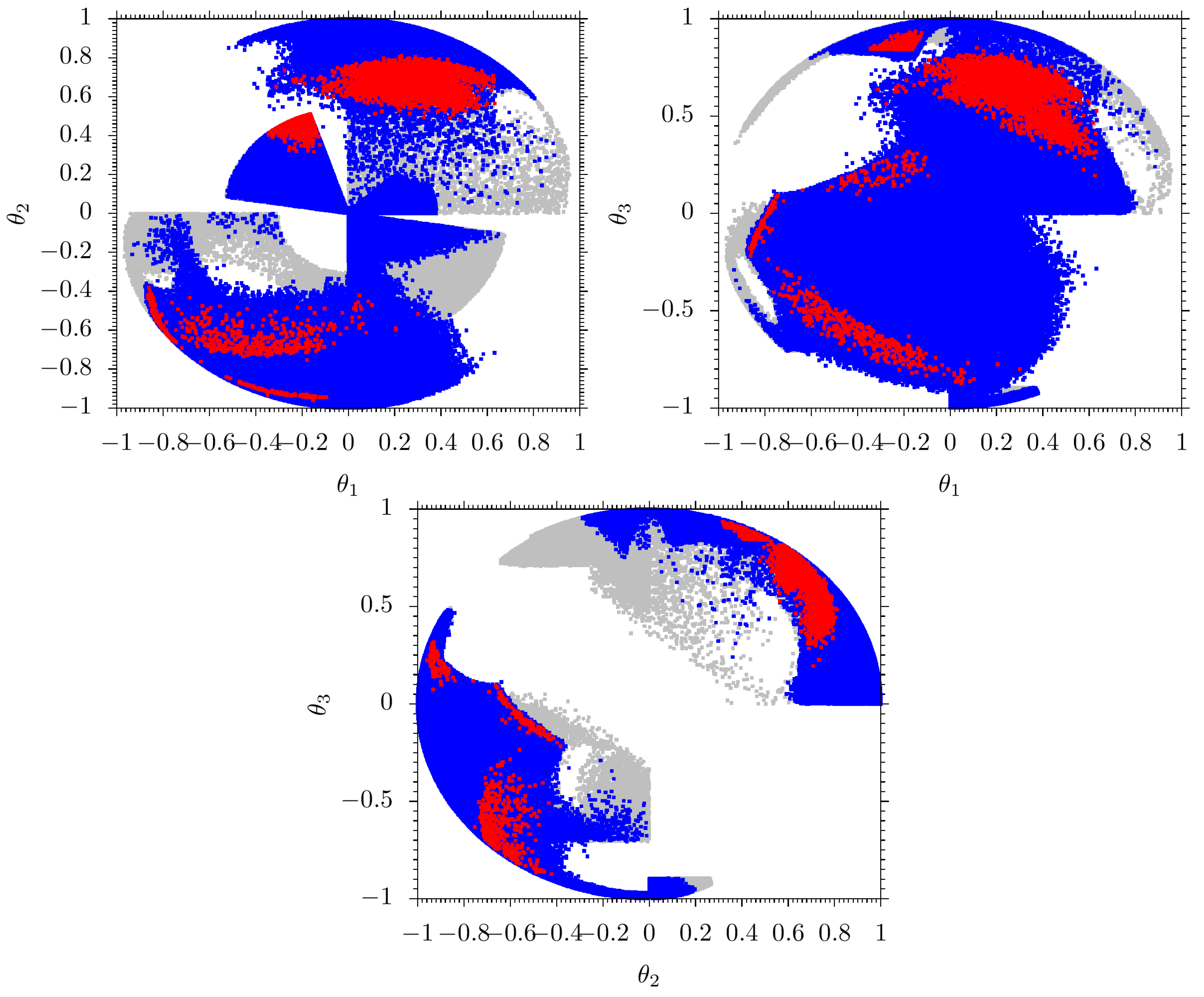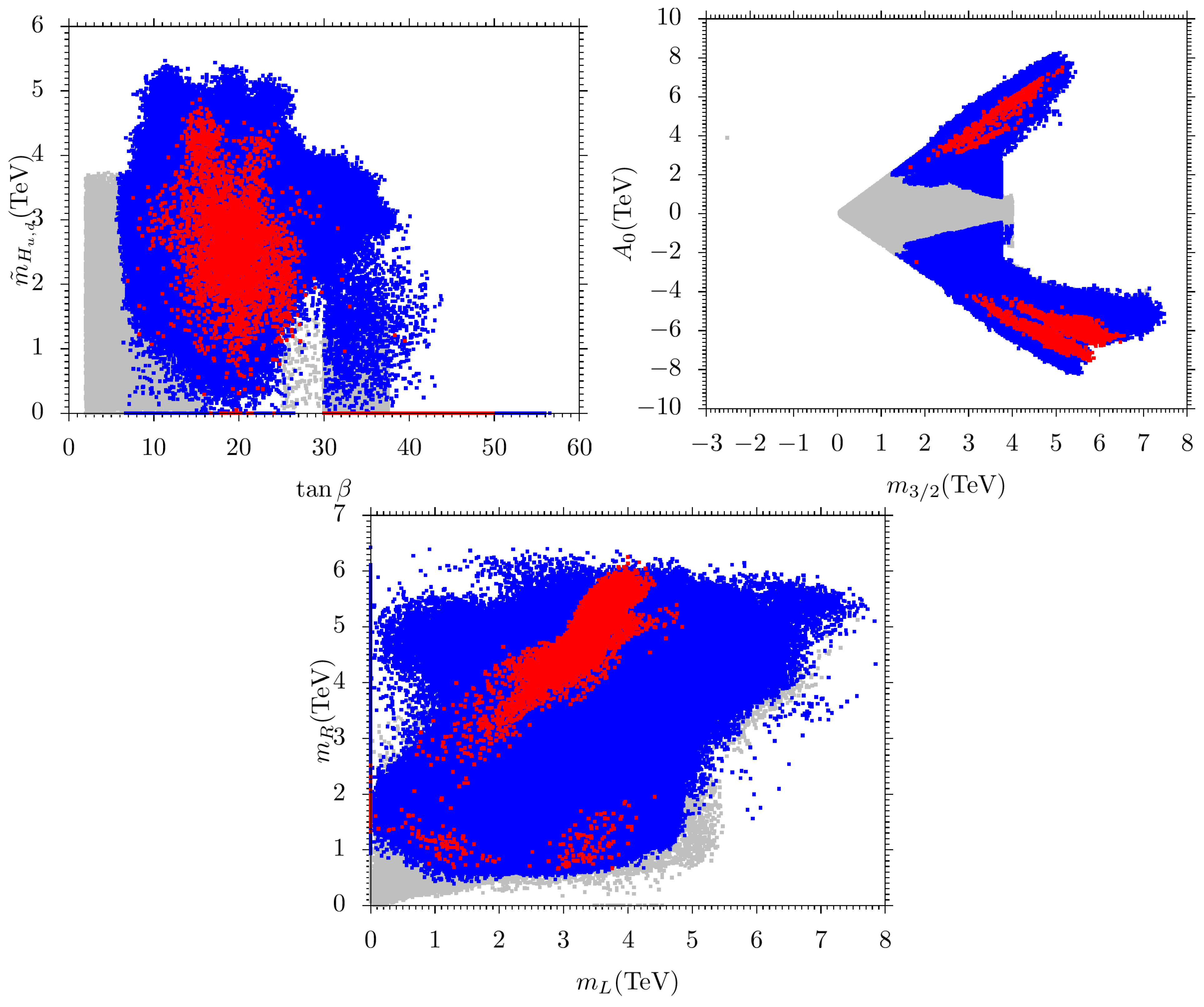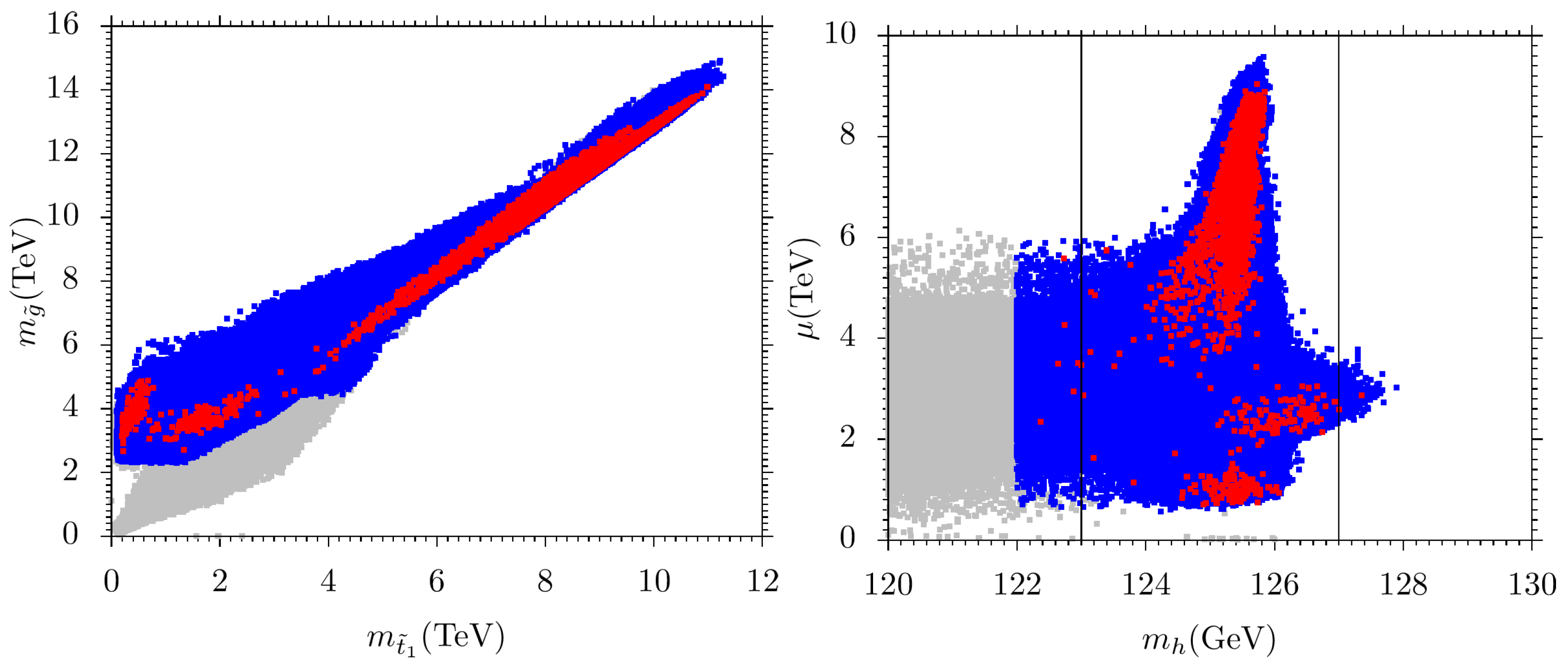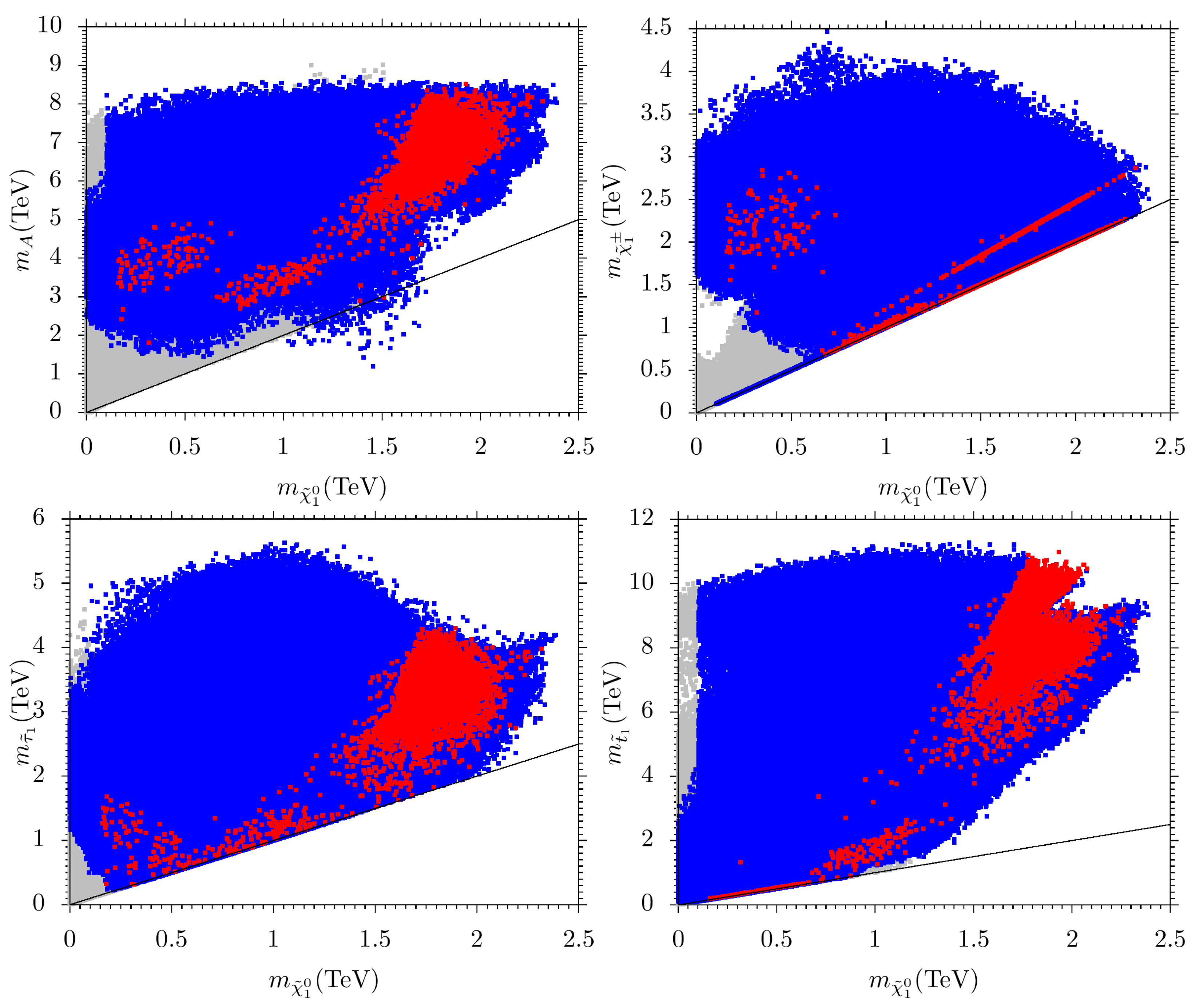Revisiting a Realistic Intersecting D6-Brane with Modified Soft SUSY Terms
Abstract
1. Introduction
2. The Realistic Pati–Salam Model from the Intersecting D6-Branes Compatified on a Orientifold
3. Scanning Procedure and Phenomenological Constraints
4. Numerical Results and Discussion
5. Summary and Conclusions
Author Contributions
Funding
Data Availability Statement
Conflicts of Interest
| 1 | The gaugino masses are almost squeezed up to 50% from the previous study, which provided an important contribution in evaluating the sparticle masses from the GUT to electroweak scale in SUSY GUTs. Similarly, the spectrum for , , , and in the negative range are also squeezed up to 50% in our new study. In short, the overall mass spectrum is squeezed from 20% to 50%. Furthermore, we are unable to have the gluino coannihilation channel in our new results, and previously we were expecting to have some points that are important regarding LHC SUSY searches. We have no stop coannihilation in the previous study and in the new study there is stop coannihilation up to 1 TeV for the Planck2018 relic density (within 5) satisfied points. Similarly, we have no stau coannihilation points below 1 TeV consistent with the Planck20018 relic density bounds within 5 and in the new study, there is stau coannihilation below 1 TeV. |
References
- Aad, G.; Abajyan, T.; Abbott, B.; Abdallah, J.; Khalek, S.A.; Abdelalim, A.A.; Aben, R.; Abi, B.; Abolins, M.; AbouZeid, O.S.; et al. Observation of a new particle in the search for the Standard Model Higgs boson with the ATLAS detector at the LHC. Phys. Lett. B 2012, 716, 1–29. [Google Scholar]
- Chatrchyan, S.; Khachatryan, V.; Sirunyan, A.M.; Tumasyan, A.; Adam, W.; Aguilo, E.; Bergauer, T.; Dragicevic, M.; Erö, J.; Fabjan, C.; et al. Observation of a new boson at a mass of 125 GeV with the CMS experiment at the LHC. Phys. Lett. B 2012, 716, 30–61. [Google Scholar]
- Dimopoulos, S.; Raby, S.; Wilczek, F. Supersymmetry and the Scale of Unification. Phys. Rev. D 1981, 24, 1681. [Google Scholar] [CrossRef]
- Marciano, W.J.; Senjanovic, G. Predictions of Supersymmetric Grand Unified Theories. Phys. Rev. D 1982, 25, 3092. [Google Scholar] [CrossRef]
- Amaldi, U.; de Boer, W.; Furstenau, H. Comparison of grand unified theories with electroweak and strong coupling constants measured at LEP. Phys. Lett. B 1991, 260, 447. [Google Scholar] [CrossRef]
- Ellis, J.R.; Kelley, S.; Nanopoulos, D.V. Probing the desert using gauge coupling unification. Phys. Lett. B 1991, 260, 131. [Google Scholar] [CrossRef]
- Langacker, P.; Luo, M.X. Implications of precision electroweak experiments for Mt, ρ0, sin2θW and grand unification. Phys. Rev. D 1991, 44, 817. [Google Scholar] [CrossRef]
- Jungman, G.; Kamionkowski, M.; Griest, K. Supersymmetric Dark Matter. Phys. Rept. 1996, 267, 195. [Google Scholar] [CrossRef]
- Aaboud, M.; Aad, G.; Abbott, B.; Abeloos, B.; Abidi, S.H.; AbouZeid, O.S.; Abraham, N.L.; Abramowicz, H.; Abreu, H.; Abreu, R.; et al. Search for squarks and gluinos in final states with jets and missing transverse momentum using 36 fb−1 of = 13 TeV pp collision data with the ATLAS detector. Phys. Rev. D 2018, 97, 112001. [Google Scholar] [CrossRef]
- Vami, T.A.; ATLAS; CMS. Searches for gluinos and squarks. In Proceedings of the 7th Large Hadron Collider Physics Conference (LHCP 2019), Puebla, Mexico, 20–25 May 2019; Volume 168. [Google Scholar] [CrossRef]
- Sirunyan, A.M.; Tumasyan, A.; Adam, W.; Ambrogi, F.; Asilar, E.; Bergauer, T.; Brandstetter, J.; Brondolin, E.; Dragicevic, M.; Erö, J.; et al. Search for new phenomena with the MT2 variable in the all-hadronic final state produced in proton–proton collisions at = 13 TeV. Eur. Phys. J. C 2017, 77, 710. [Google Scholar] [CrossRef]
- Leggett, T.; Li, T.; Maxin, J.A.; Nanopoulos, D.V.; Walker, J.W. No Naturalness or Fine-tuning Problems from No-Scale Supergravity. arXiv 2014, arXiv:1403.3099. [Google Scholar]
- Leggett, T.; Li, T.; Maxin, J.A.; Nanopoulos, D.V.; Walker, J.W. Confronting Electroweak Fine-tuning with No-Scale Supergravity. Phys. Lett. B 2015, 740, 66. [Google Scholar] [CrossRef]
- Du, G.; Li, T.; Nanopoulos, D.V.; Raza, S. Super-Natural MSSM. Phys. Rev. D 2015, 92, 025038. [Google Scholar]
- Cremmer, E.; Ferrara, S.; Kounnas, C.; Nanopoulos, D.V. Naturally Vanishing Cosmological Constant In N = 1 Supergravity. Phys. Lett. B 1983, 133, 61. [Google Scholar] [CrossRef]
- Ellis, J.R.; Lahanas, A.B.; Nanopoulos, D.V.; Tamvakis, K. No-Scale Supersymmetric Standard Model. Phys. Lett. B 1984, 134, 429. [Google Scholar]
- Ellis, J.R.; Kounnas, C.; Nanopoulos, D.V. Phenomenological SU(1,1) Supergravity. Nucl. Phys. B 1984, 241, 406. [Google Scholar] [CrossRef]
- Ellis, J.R.; Kounnas, C.; Nanopoulos, D.V. No Scale Supersymmetric Guts. Nucl. Phys. B 1984, 247, 373. [Google Scholar] [CrossRef]
- Lahanas, A.B.; Nanopoulos, D.V. The Road to No Scale Supergravity. Phys. Rept. 1987, 145, 1–139. [Google Scholar] [CrossRef]
- Giudice, G.F.; Masiero, A. A Natural Solution to the mu Problem in Supergravity Theories. Phys. Lett. B 1988, 206, 480. [Google Scholar] [CrossRef]
- Berkooz, M.; Douglas, M.R.; Leigh, R.G. Branes intersecting at angles. Nucl. Phys. B 1996, 480, 265. [Google Scholar] [CrossRef]
- Ibanez, L.E.; Marchesano, F.; Rabadan, R. Getting just the standard model at intersecting branes. J. High Energy Phys. 2001, 0111, 2. [Google Scholar]
- Blumenhagen, R.; Kors, B.; Lust, D.; Ott, T. The standard model from stable intersecting brane world orbifolds. Nucl. Phys. B 2001, 616, 3–33. [Google Scholar]
- Cvetič, M.; Shiu, G.; Uranga, A.M. Three-family supersymmetric standardlike models from intersecting brane worlds. Phys. Rev. Lett. 2001, 87, 201801. [Google Scholar] [CrossRef] [PubMed]
- Cvetič, M.; Shiu, G.; Uranga, A.M. Chiral four-dimensional N = 1 supersymmetric type IIA orientifolds from intersecting D6-branes. Nucl. Phys. B 2001, 615, 3. [Google Scholar] [CrossRef]
- Cvetič, M.; Papadimitriou, I.; Shiu, G. Supersymmetric three family SU(5) grand unified models from type IIA orientifolds with intersecting D6-branes. Nucl. Phys. B 2003, 659, 193, Erratum in Nucl. Phys. B 2004, 696, 298. [Google Scholar] [CrossRef][Green Version]
- Cvetic, M.; Li, T.; Liu, T. Supersymmetric patiSalam models from intersecting D6-branes: A Road to the standard model. Nucl. Phys. B 2004, 698, 163. [Google Scholar] [CrossRef]
- Cvetic, M.; Langacker, P.; Li, T.; Liu, T. D6-brane splitting on type IIA orientifolds. Nucl. Phys. B 2005, 709, 241. [Google Scholar] [CrossRef][Green Version]
- Cvetic, M.; Li, T.; Liu, T. Standard-like models as type IIB flux vacua. Phys. Rev. D 2005, 71, 106008. [Google Scholar] [CrossRef]
- Chen, C.-M.; Kraniotis, G.V.; Mayes, V.E.; Nanopoulos, D.V.; Walker, J.W. A supersymmetric flipped SU(5) intersecting brane world. Phys. Lett. B 2005, 611, 156. [Google Scholar] [CrossRef][Green Version]
- Chen, C.-M.; Kraniotis, G.V.; Mayes, V.E.; Nanopoulos, D.V.; Walker, J.W. A K-theory anomaly free supersymmetric flipped SU(5) model from intersecting branes. Phys. Lett. B 2005, 625, 96. [Google Scholar] [CrossRef][Green Version]
- Chen, C.M.; Li, T.; Nanopoulos, D.V. Standard-like model building on type II orientifolds. Nucl. Phys. B 2006, 732, 224. [Google Scholar] [CrossRef][Green Version]
- Blumenhagen, R.; Cvetic, M.; Langacker, P.; Shiu, G. Toward realistic intersecting D-brane models. Ann. Rev. Nucl. Part. Sci. 2005, 55, 71. [Google Scholar] [CrossRef]
- Pati, J.C.; Salam, A. Lepton Number as the Fourth Color. Phys. Rev. D 1974, 10, 275, Erratum in Phys. Rev. D 1975, 11, 703. [Google Scholar] [CrossRef]
- Chen, C.M.; Li, T.; Mayes, V.E.; Nanopoulos, D.V. A Realistic world from intersecting D6-branes. Phys. Lett. B 2008, 665, 267. [Google Scholar] [CrossRef][Green Version]
- Chen, C.M.; Li, T.; Mayes, V.E.; Nanopoulos, D.V. Towards realistic supersymmetric spectra and Yukawa textures from intersecting branes. Phys. Rev. D 2008, 77, 125023. [Google Scholar] [CrossRef]
- Li, T.; Nanopoulos, D.V.; Raza, S.; Wang, X.C. A Realistic Intersecting D6-Brane Model after the First LHC Run. J. High Energy Phys. 2014, 1408, 128. [Google Scholar] [CrossRef]
- Sabir, M.; Li, T.; Mansha, A.; Wang, X.C. The supersymmetry breaking soft terms, and fermion masses and mixings in the supersymmetric Pati-Salam model from intersecting D6-branes. J. High Energy Phys. 2022, 4, 89. [Google Scholar] [CrossRef]
- Baer, H.; Paige, F.E.; Protopopescu, S.D.; Tata, X. ISAJET 7.48: A Monte Carlo event generator for p p, anti-p p, and e+ e-reactions. arXiv 2003, arXiv:hep-ph/0001086. [Google Scholar]
- Tevatron Electroweak Working Group; CDF Collaboration; D0 Collab. Combination of CDF and D0 Results on the Mass of the Top Quark. arXiv 2009, arXiv:0903.2503. [Google Scholar]
- Belanger, G.; Boudjema, F.; Pukhov, A.; Singh, R.K. Constraining the MSSM with universal gaugino masses and implication for searches at the LHC. J. High Energy Phys. 2009, 911, 26. [Google Scholar] [CrossRef]
- Baer, H.; Kraml, S.; Sekmen, S.; Summy, H. Dark matter allowed scenarios for Yukawa-unified SO(10) SUSY GUTs. J. High Energy Phys. 2008, 803, 56. [Google Scholar] [CrossRef]
- Patrignani, C.; Agashe, K.; Aielli, G.; Amsler, C.; Antonelli, M.; Asner, D.M.; Baer, H.; Banerjee, S.; Barnett, R.M.; Basaglia, T.; et al. Review of Particle Physics. Chin. Phys. C 2016, 40, 100001. [Google Scholar]
- Aad, G.; Abbott, B.; Abbott, D.C.; Abud, A.A.; Abeling, K.; Abhayasinghe, D.K.; Abidi, S.H.; AbouZeid, O.S.; Abraham, N.L.; Abramowicz, H.; et al. Measurements of the Higgs boson production and decay rates and constraints on its couplings from a combined ATLAS and CMS analysis of the LHC pp collision data at = 7 and 8 TeV. J. High Energy Phys. 2016, 1608, 45. [Google Scholar]
- Slavich, P.; Heinemeyer, S.; Bagnaschi, E.; Bahl, H.; Goodsell, M.; Haber, H.E.; Hahn, T.; Harlander, R.; Hollik, W.; Lee, G.; et al. Higgs-mass predictions in the MSSM and beyond. Eur. Phys. J. C 2021, 81, 450. [Google Scholar] [CrossRef]
- Allanach, B.C.; Djouadi, A.; Kneur, J.L.; Porod, W.; Slavich, P. Precise determination of the neutral Higgs boson masses in the MSSM. J. High Energy Phys. 2004, 9, 44. [Google Scholar] [CrossRef]
- Baer, H.; Brhlik, M. Signals for the minimal gauge-mediated supersymmetry-breaking model at the Fermilab Tevatron collider. Phys. Rev. D 1997, 55, 4463. [Google Scholar] [CrossRef]
- Baer, H.; Brhlik, M.; Castano, D.; Tata, X. b→ s γconstraints on the minimal supergravity model with large tan β. Phys. Rev. D 1998, 58, 015007. [Google Scholar] [CrossRef]
- Babu, K.; Kolda, C. Higgs-mediated B0→μ+μ− in minimal supersymmetry. Phys. Rev. Lett. 2000, 84, 228. [Google Scholar] [CrossRef] [PubMed]
- Dedes, A.; Dreiner, H.; Nierste, U. Correlation of Bs→μ+μ− and (g − 2) μ in minimal supergravity. Phys. Rev. Lett. 2001, 87, 251804. [Google Scholar] [CrossRef] [PubMed]
- Mizukoshi, J.K.; Tata, X.; Wang, Y. Higgs-mediated leptonic decays of Bs and Bd mesons as probes of supersymmetry. Phys. Rev. D 2002, 66, 115003. [Google Scholar] [CrossRef]
- Khachatryan, V.; Sirunyan, A.M.; Tumasyan, A.; Adam, W.; Bergauer, T.; Filipovic, N.; Bencze, G.; Hajdu, C.; Hidas, P.; Horváth, D.; et al. Observation of the rare →μ+μ− decay from the combined analysis of CMS and LHCb data. Nature 2015, 522, 68. [Google Scholar]
- Amhis, Y.; Banerjee, S.; Ben-Haim, E.; Blyth, S.; Bozek, A.; Bozzi, C.; Carbone, A.; Chistov, R.; Chrząszcz, M.; Cibinetto, G.; et al. Averages of b-hadron, c-hadron, and τ-lepton properties as of summer 2014. arXiv 2014, arXiv:1412.7515. [Google Scholar]
- Aghanim, N.; Akrami, Y.; Arroja, F.; Ashdown, M.; Aumont, J.; Baccigalupi, C.; Ballardini, M.; Banday, A.J.; Barreiro, R.B.; Bartolo, N.; et al. Planck 2018 results. I. Overview and the cosmological legacy of Planck. Astron. Astrophys. 2020, 641, A1. [Google Scholar] [CrossRef]
- Cohen, T.; Golling, T.; Hance, M.; Henrichs, A.; Howe, K.; Loyal, J.; Padhi, S.; Wacker, J.G. SUSY Simplified Models at 14, 33, and 100 TeV Proton Colliders. J. High Energy Phys. 2014, 4, 117. [Google Scholar] [CrossRef]
- Arkani-Hamed, N.; Han, T.; Mangano, M.; Wang, L.T. Physics opportunities of a 100 TeV proton–proton collider. Phys. Rept. 2016, 652, 1–49. [Google Scholar] [CrossRef]
- Fan, J.; Jaiswal, P.; Leung, S.C. Jet Observables and Stops at 100 TeV Collider. Phys. Rev. D 2017, 96, 036017. [Google Scholar] [CrossRef]
- Golling, T.; Hance, M.; Harris, P.; Mangano, M.L.; McCullough, M.; Moortgat, F.; Schwaller, P.; Torre, R.; Agrawal, P.; Alves, D.S.M.; et al. Physics at a 100 TeV pp collider: Beyond the Standard Model phenomena. arXiv 2016, arXiv:1606.00947. [Google Scholar] [CrossRef]
- Tumasyan, A.; Adam, W.; Andrejkovic, J.W.; Bergauer, T.; Chatterjee, S.; Damanakis, K.; Dragicevic, M.; Del Valle, A.E.; Fruehwirth, R.; Jeitler, M.; et al. Searches for additional Higgs bosons and for vector leptoquarks in ττ final states in proton-proton collisions at = 13 TeV. arXiv 2022, arXiv:2208.02717. [Google Scholar]
- Baer, H.; Barger, V.; Tata, X.; Zhang, K. Prospects for Heavy Neutral SUSY HIGGS Scalars in the hMSSM and Natural SUSY at LHC Upgrades. Symmetry 2022, 14, 2061. [Google Scholar] [CrossRef]
- Baer, H.; Barger, V.; Tata, X.; Zhang, K. Detecting heavy neutral SUSY Higgs bosons decaying to sparticles at the high-luminosity LHC. arXiv 2022, arXiv:2212.09198. [Google Scholar]
- [ATLAS]. SUSY Summary Plots June 2021. ATL-PHYS-PUB-2021-019. Available online: https://cds.cern.ch/record/2771785/files/ATL-PHYS-PUB-2021-019.pdf (accessed on 25 February 2024).
- Tumasyan, A.; Adam, W.; Andrejkovic, J.W.; Bergauer, T.; Chatterjee, S.; Damanakis, K.; Dragicevic, M.; Escalante Del Valle, A.; Fruehwirth, R.; Jeitler, M.; et al. Search for direct pair production of supersymmetric partners of τ leptons in the final state with two hadronically decaying τ leptons and missing transverse momentum in proton-proton collisions at = 13 TeV. arXiv 2022, arXiv:2207.02254. [Google Scholar]
- Aad, G.; Abbott, B.; Abbott, D.C.; Abud, A.A.; Abeling, K.; Abhayasinghe, D.K.; Abidi, S.H.; AbouZeid, O.S.; Abraham, N.L.; Abramowicz, H.; et al. Search for new phenomena in events with an energetic jet and missing transverse momentum in pp collisions at = 13 TeV with the ATLAS detector. Phys. Rev. D 2021, 103, 112006. [Google Scholar]
- [ATLAS]. SUSY March 2023 Summary Plot Update. ATL-PHYS-PUB-2023-005. Available online: https://atlas.web.cern.ch/Atlas/GROUPS/PHYSICS/PUBNOTES/ATL-PHYS-PUB-2023-005/ (accessed on 25 February 2024).
- Akerib, D.S.; Alsum, S.; Araújo, H.M.; Bai, X.; Bailey, A.J.; Balajthy, J.; Beltrame, P.; Bernard, E.P.; Bernstein, A.; Biesiadzinski, T.P.; et al. Results from a search for dark matter in the complete LUX exposure. Phys. Rev. Lett. 2017, 118, 021303. [Google Scholar] [CrossRef] [PubMed]
- Aprile, E.; Aalbers, J.; Agostini, F.; Alfonsi, M.; Amaro, F.D.; Anthony, M.; Arneodo, F.; Barrow, P.; Baudis, L.; Bauermeister, B.; et al. First Dark Matter Search Results from the XENON1T Experiment. Phys. Rev. Lett. 2017, 119, 181301. [Google Scholar] [CrossRef] [PubMed]
- Collaboration, X.E.N.O.N.; Aprile, E.; Aalbers, J.; Agostini, F.; Alfonsi, M.; Althueser, L.; Amaro, F.D.; Anthony, M.; Arneodo, F.; Baudis, L.; et al. Dark Matter Search Results from a One Ton-Year Exposure of XENON1T. Phys. Rev. Lett. 2018, 121, 111302. [Google Scholar]
- Aprile, E.; Aalbers, J.; Agostini, F.; Alfonsi, M.; Amaro, F.D.; Anthony, M.; Arazi, L.; Arneodo, F.; Balan, C.; Barrow, P.; et al. Physics reach of the XENON1T dark matter experiment. J. Cosmol. Astropart. Phys. 2016, 1604, 27. [Google Scholar] [CrossRef]
- Akerib, D.S.; Alsum, S.; Araújo, H.M.; Bai, X.; Bailey, A.J.; Balajthy, J.; Beltrame, P.; Bernard, E.P.; Bernstein, A.; Biesiadzinski, T.P.; et al. Limits on spin-dependent WIMP-nucleon cross section obtained from the complete LUX exposure. Phys. Rev. Lett. 2017, 118, 251302. [Google Scholar] [CrossRef] [PubMed]
- Akerib, D.S.; Araújo, H.M.; Bai, X.; Bailey, A.J.; Balajthy, J.; Beltrame, P.; Bernard, E.P.; Bernstein, A.; Biesiadzinski, T.P.; Boulton, E.M.; et al. Results on the Spin-Dependent Scattering of Weakly Interacting Massive Particles on Nucleons from the Run 3 Data of the LUX Experiment. Phys. Rev. Lett. 2016, 116, 161302. [Google Scholar] [CrossRef]
- Abbasi, R.; Abdou, Y.; Ackermann, M.; Adams, J.; Ahlers, M.; Andeen, K.; Auffenberg, J.; Bai, X.; Baker, M.; Barwick, S.W.; et al. Limits on a muon flux from neutralino annihilations in the Sun with the IceCube 22-string detector. Phys. Rev. Lett. 2009, 102, 201302. [Google Scholar] [CrossRef]






| Point 1 | Point 2 | Point 3 | Point 4 | |
|---|---|---|---|---|
| 1242.9 | 1931.8 | 1779.7 | 905.2 | |
| 1748.8 | 787.7 | 4152 | 748.2 | |
| 1630.2 | −1989.9 | −2943.9 | −1871.1 | |
| 887.3 | −2120.4 | −2256.8 | −1713.6 | |
| 2164.8 | −1796.9 | −4523.8 | −1421.3 | |
| −2475.7 | 4032.3 | 4920.8 | 3151.6 | |
| 16.3 | 12 | 39.5 | 16.9 | |
| 987 | 3481 | 1122.3 | 2634.9 | |
| 2944.2 | 999.7 | 5797 | 859 | |
| 122.8 | 125.7 | 125.4 | 125.1 | |
| 3064 | 3804 | 2919 | 2842 | |
| 3044 | 3779 | 2900 | 2823 | |
| 3065 | 3805 | 2921 | 2843 | |
| 711, −724 | 876, −1015 | 1388, 1694 | 807, −873 | |
| 2954, −2955 | −1015, 1763 | −5786, 5787 | 897, 1413 | |
| 724, 2958 | 985, 1738 | 1698, 5783 | 838, 1398 | |
| 4546 | 3810 | 8888 | 3049 | |
| 4096, 4284 | 3994, 3366 | 7874, 8552 | 2967, 2763 | |
| 3376, 3693 | 911, 3237 | 6428, 7095 | 1164, 2346 | |
| 4097, 4274 | 3343, 3995 | 7875, 8536 | 2968, 2739 | |
| 3656, 3693 | 3234, 3283 | 6496, 7416 | 2362, 2604 | |
| 1380 | 2369 | 2559 | 1450 | |
| 1338 | 2336 | 2258 | 1383 | |
| 1386, 1847 | 2370, 1064 | 2550, 4133 | 1455, 1017 | |
| 1342, 1784 | 912, 2338 | 2554, 3732 | 821, 1390 | |
| 0.119 | 0.119 | 0.117 | 0.114 |
Disclaimer/Publisher’s Note: The statements, opinions and data contained in all publications are solely those of the individual author(s) and contributor(s) and not of MDPI and/or the editor(s). MDPI and/or the editor(s) disclaim responsibility for any injury to people or property resulting from any ideas, methods, instructions or products referred to in the content. |
© 2024 by the authors. Licensee MDPI, Basel, Switzerland. This article is an open access article distributed under the terms and conditions of the Creative Commons Attribution (CC BY) license (https://creativecommons.org/licenses/by/4.0/).
Share and Cite
Khan, I.; Ahmed, W.; Li, T.; Raza, S. Revisiting a Realistic Intersecting D6-Brane with Modified Soft SUSY Terms. Universe 2024, 10, 176. https://doi.org/10.3390/universe10040176
Khan I, Ahmed W, Li T, Raza S. Revisiting a Realistic Intersecting D6-Brane with Modified Soft SUSY Terms. Universe. 2024; 10(4):176. https://doi.org/10.3390/universe10040176
Chicago/Turabian StyleKhan, Imtiaz, Waqas Ahmed, Tianjun Li, and Shabbar Raza. 2024. "Revisiting a Realistic Intersecting D6-Brane with Modified Soft SUSY Terms" Universe 10, no. 4: 176. https://doi.org/10.3390/universe10040176
APA StyleKhan, I., Ahmed, W., Li, T., & Raza, S. (2024). Revisiting a Realistic Intersecting D6-Brane with Modified Soft SUSY Terms. Universe, 10(4), 176. https://doi.org/10.3390/universe10040176







